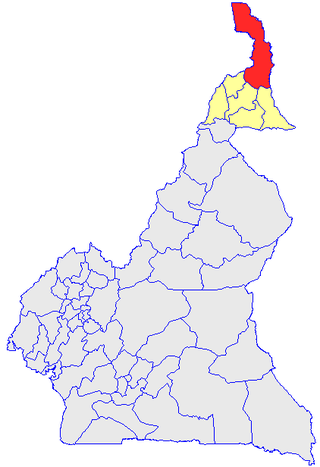Related Research Articles

Hausa ; Ajami: هَرْشٜن هَوْسَ) is a Chadic language spoken by the Hausa people in the northern half of Nigeria, Niger, Ghana, Cameroon, Benin and Togo, and the southern half of Niger, Chad and Sudan, with significant minorities in Ivory Coast.

The Biu–Mandara or Central Chadic languages of the Afro-Asiatic family are spoken in Nigeria, Chad and Cameroon.
Massa is a Chadic language spoken in southern Chad and northern Cameroon by the Masa people. It has approximately 200,000 speakers.
The Kom language is the language spoken by the Kom people in Northwest Province in Cameroon. It is classified as a Central Ring language of the Grassfields, Southern Bantoid languages in the Niger-Congo language family. Kom is a tonal language with three tones.
Marba is an Afro-Asiatic language spoken by the Azumeina peoples of Chad as their first language. It is also the name of one of the Azumeina peoples.
Kera is an East Chadic language spoken by 45,000 people in Southwest Chad and 6,000 people in North Cameroon.
Afade (Afaɗə) is an Afro-Asiatic language spoken in eastern Nigeria and northwestern Cameroon.
Malgbe is an Afro-Asiatic language spoken in northern Cameroon and southwestern Chad. Dialects are Douguia, Dro, Malgbe, Mara, and Walia.
Mpadə is an Afro-Asiatic language spoken in northern Cameroon and southwestern Chad. Dialects are Bodo, Biamo, Digam, Mpade (Makari), Shoe (Shewe), and Woulki.
Mser (Msər), or Kousseri (Kuseri), is a moribund Afro-Asiatic language spoken in northern Cameroon and southwestern Chad. Dialects are Gawi, Houlouf, Kabe, Kalo, Mser (Kuseri).
Bana is an Afro-Asiatic language spoken in northern Cameroon. Dialects include Gamboura and Gili.
Yedina, also known as Buduma (Boudouma), is a Chadic language of the Biu–Mandara branch spoken around Lake Chad in western Chad and neighbouring Cameroon and Nigeria.

Logone-et-Chari is a department of Extreme-Nord Province in Cameroon. The department covers an area of 12,133 km2 and at the 2005 Census had a total population of 486,997. The capital of the department is at Kousséri. Most inhabitants of this department speak Chadian Arabic.
Musgu is a cluster of closely related language varieties of the Biu–Mandara subgroup of the Chadic languages spoken in Cameroon and Chad. The endonym is Mulwi. Blench (2006) classifies the three varieties as separate languages. Speakers of the extinct related language Muskum have switched to one of these.
Yiwom (Ywom), also known as Gerka or Gerkawa by the Hausa, is a Chadic (Afro-Asiatic) language spoken in Plateau State, Nigeria.
Wandala, also known as Mandara or Mura', is a language in the Chadic branch of the Afro-Asiatic language family, spoken in Cameroon and Nigeria.

The Pévé language, sometimes referred to as Lamé, is a member of the Masa branch of the Chadic family that is spoken in parts of Cameroon and the Republic of Chad.
Jina (Zina) is an Afroasiatic language of Cameroon. The Muxule variety may be a distinct language.
Majera (Mazera) is a minor Afro-Asiatic language of Chad and Cameroon.
Karang language is an Mbum language of Cameroon and Chad.
References
- Johannes Lukas. 1936. Die Logone-Sprache im Zentralen Sudan. Leipzig: DMG.
- Joy Naomi Ruff. 2005. Phonology of Lagwan. Cameroon.